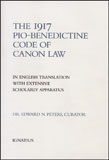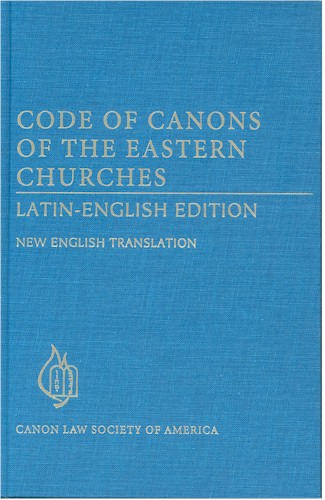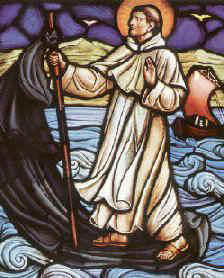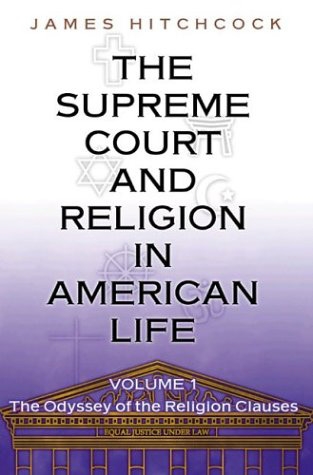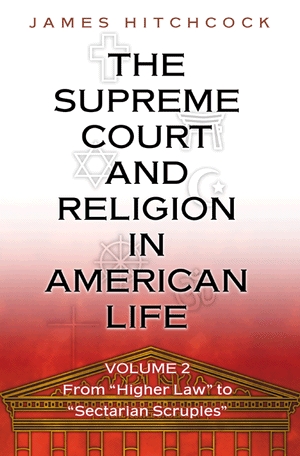|
To work for the proper implementation of canon law is to play an extraordinarily constructive role in continuing the redemptive mission of Christ. Pope John Paul II |
|
|
|
|
Resolution 1152 x 864 |
Updated 6 jan 2013 |
Review of J. Hitchcock, Supreme Court and Religion in American Life, 2 vols., (Princeton, 2004) 504 pp. |
|
Edward Peters, Review of: J. Hitchcock, The Supreme Court and Religion in American Life, 2 vols., (Princeton, 2004), in The Jurist 66 (2006) 499-503.
Hitchcock, Vol. I
Hitchcock, Vol. II
See also
James Hitchcock, Ph. D. Department of History
|
The Supreme Court of the United States of America is the most powerful judicial tribunal in the world. It has been such for something approaching a century not simply because it sits astride the most economically and militarily powerful nation on earth, but also because of the degree of freedom with which it operates and the range of erudition that it can draw on in its work. As the oldest continuously functioning liberal democracy in the world, what America says (here, through its highest court) about religion and its role in public life carries great weight in the West, even if sometimes that prestige is illuminated negatively by other systems feeling the need to point out how different they are from America. In any case, the US Supreme Court is a source of jurisprudence that is, and will likely remain for the foreseeable future, unparalleled in the world.
Dr. James Hitchcock, professor of history at St. Louis University and an authority on civil and ecclesiastical politics in the United States, has written an important work on the treatment of religion by its Supreme Court. His study, divided into two volumes of very different structure, introduces the intelligent but not legally trained reader to what is probably every significant case wherein the high court has treated religion and applies to them the kind of insightful historical analysis that few besides Hitchcock could offer. The picture that Hitchcock paints of the constitutional scrutiny accorded religion is not always a pretty one, but it is an important one, and it is one with which American canonists should be familiar. To be sure, while Catholic justices and what we may call Catholic cases have played a significant role in Supreme Court jurisprudence, Hitchcock’s study is not about Catholics or Catholicism in the Supreme Court, but rather about religion and law in public life.
American canonists could find Hitchcock’s study of interest at three levels: first, of course, as citizens broadly interested in the great issues that confront their country; second, as advisors to Catholic leaders and institutions that in many areas (including educational programs, political activism, health care administration, and property rights, to name a few) must accommodate the decisions of the Supreme Court in their activities, or be well-prepared not to accommodate them if it comes to that; and third, as lawyers in a legal system that does not know judicial review by an independent judiciary (see 1983 CIC 16 § 3), for instruction as to how judicial review might over time be incorporated into canonical practice.
Hitchcock’s study can be fruitfully studied in a couple of ways. Most obviously, he divides his work into two volumes, the first of which is heavily narrative, while the second is analytical of all major religion cases since the founding of the Republic until early in the 21st century. Within both volumes, Hitchcock clearly presents the great transition in the high court’s treatment of religion that occurred during and just after the Second World War, a change from its earlier accommodationist respect for the “higher principles” of religion, to its increasing separationist suspicion of so-called “sectarian” divisiveness. Moreover, and although this is harder to see until one is well into the analytical second volume, Hitchcock suggests themes that, especially since Everson (1947) and McCollum (1948), have been the hooks upon which the Court has hung its decisions, including: the search for (and increasingly, the manipulation of) “original intent”; the alleged “diverseness” of religion; the relegation of faith to the private sphere; and a denigration of religion as something “irrational” whose educational methods are consequently little more than “indoctrination”.
My remarks on Hitchcock’s volume I are few and mostly pedagogic, not substantive.
Volume one, presented as “the most comprehensive survey of the religion cases” that have come before the Supreme Court, is not easy reading, especially if one is not trained in the common law. Hitchcock assumes that readers already know what the two religion clauses actually say, that they understand how the Supreme Court fits into the American scheme of constitutional government, and that they have a good sense as to how the high court operates in accepting or rejecting cases, in discussing those that are accepted, and in voting on them. I think these assumptions are too generous and I would have preferred to see a brief essay by Hitchcock outlining these areas for the uninitiated. Moreover, few explanations of various technical issues (e.g., “estates of the realm”, “corporation sole”, “diversity of citizenship”, and “circuit justice”) are offered. But besides these, an additional point should be mentioned.
The early decades of the Supreme Court show an institution finding its way, using, as it were, the cases that came before it as food for its own growth. Among those cases were, admittedly, disputes between religious groups, but the issues raised in those cases were often not primarily religious, and indeed, frequently they were barely “constitutional”. To achieve the goal of making his the most comprehensive survey of religion cases, Hitchcock has included a number of high court cases, particularly very early 19th century cases, whose relevance to the religion clauses is not immediately apparent to us today. In several instances, in my view, a little more discussion of the underlying facts of these cases would have been helpful for seeing the constitutional questions posed by what certainly look like, and might have been treated by the early Court as, cases sounding in contracts and property, even though they were brought by or against religious parties. At a minimum, then, readers should bear in mind that for the first 50 years of the Republic’s existence, a number of cases were taken up by the Supreme Court with as much an eye toward their ability to define the high court’s constitutional jurisdiction as to settling the legal questions at issue.
Hitchcock deliberately leaves most of his excellent commentary for the second volume so that, to put it colloquially, readers moving through volume one might feel as though they are more or less “on their own”. In fact, I want to suggest (with some trepidation) that these two volumes, for many people, will be more useable if one overlooks Hitchcock’s suggestion and, instead of reading all of volume one before moving to volume two, one simply reads the final summary chapter of volume one and moves directly to volume two, referring back to volume one on an as-needed basis. This will help those without specific legal training from getting bogged down in the highly technical discussions in volume one, and let them move directly to the analytic and accessible presentations that Hitchcock offers so well in volume two.
Hitchcock’s volume II moves swiftly. Chapters one and three enable readers to follow the high court’s search for understanding of the import of the Establishment and Free Exercises Clauses of the US Constitution. In particular, Hitchcock’s narration shows the malleability of historical sources by those who plumb them with pre-determined outcomes in mind, but he leaves little doubt that the hostility shown in recent decades by the Supreme Court to religious values in America is without historical justification. Chapters two and five pay special regard to the “juridic mechanics” (my term, not Hitchcock’s) by which social and legal principles are debated and incorporated—or rejected—in high court opinions, suggesting as he does some ways in which American religious jurisprudence might be rehabilitated without undue damage to the otherwise generally sounds principles of common law such as stare decisis and judicial precedent.
Chapter four on the religious background of leading Supreme Court justices cannot be said to be a focal point of Hitchcock’s analysis (for he generally takes men at their word and avoids psychoanalyzing them) but for all that, his discoveries here make fascinating reading. Hugo Black, for example, architect of the Everson and McCollum decisions and later the justice whose obiter dicta introduced Secular Humanism into the catalogue of constitutionally recognized religions, was, it seems, more than the nominal member of the Ku Klux Klan he admitted to being. Black gave lectures to the KKK on the dangers of Roman Catholicism (lectures he developed through his reading of the notorious anti-Catholic Paul Blanchard), was an unrelenting opponent of the natural law tradition (often mistakenly perceived as being dependent on Catholic theology for it cohesiveness) and, despite being in other respects a loyal Democrat, Black opposed Alfred Smith’s bid for the presidency on the basis of Smith’s Catholic faith. Can such a background really be ignored by those trying to understand Black’s campaign against religion in public life? To take a later example of Hitchcock’s ability to present balanced views of the religious backgrounds of those who shape Court thinking on religion, in these pages Antonin Scalia’s ambiguity as a Catholic legal thinker emerges, while Clarence Thomas (who strayed from the Church for many years before returning in an apparently sincere manner in 1996) comes across as one quite able to apply the wisdom of Catholic legal thought in a variety of ways. Justices Frankfurter, Douglas, Jackson, and Murphy are among the other jurists that Hitchcock studies in an enlightening manner.
I am grateful to James Hitchcock for having assembled such a comprehensive guide to the religious jurisprudence of the US Supreme Court, and I am impressed by the ability of this historian to shed so much light on the legal criterion being applied by the men and women who shape American law at its highest levels.
|

